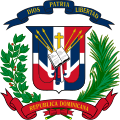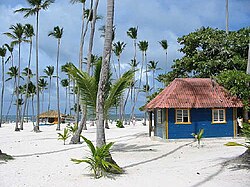Portal:Dominican Republic
Introduction
The Dominican Republic is a country located on the island of Hispaniola in the Greater Antilles of the Caribbean Sea in the North Atlantic Ocean. It shares a maritime border with Puerto Rico to the east and a land border with Haiti to the west, occupying the eastern five-eighths of Hispaniola which, along with Saint Martin, is one of only two islands in the Caribbean shared by two sovereign states. In the Antilles, the country is the second-largest nation by area after Cuba at 48,671 square kilometers (18,792 sq mi) and second-largest by population after Haiti with approximately 11.4 million people in 2024, of whom 3.6 million reside in the metropolitan area of Santo Domingo, the capital city. The Dominican Republic has the largest economy in the Caribbean and the seventh-largest in Latin America. Over the last 25 years, the Dominican Republic has had the fastest-growing economy in the Western Hemisphere – with an average real GDP growth rate of 5.3% between 1992 and 2018. GDP growth in 2014 and 2015 reached 7.3 and 7.0%, respectively, the highest in the Western Hemisphere. Recent growth has been driven by construction, manufacturing, tourism, and mining. The country is the site of the third largest (in terms of production) gold mine in the world, the Pueblo Viejo mine. The gold production of the country is 31 metric tonnes in 2015. The Dominican Republic is the most visited destination in the Caribbean. A geographically diverse nation, the Dominican Republic is home to both the Caribbean's tallest mountain peak, Pico Duarte, and the Caribbean's largest lake and lowest point, Lake Enriquillo. The island has an average temperature of 26 °C (78.8 °F) and great climatic and biological diversity. The country is also the site of the first cathedral, palace, monastery, and fortress built in the Americas, located in Santo Domingo's Colonial Zone, a World Heritage Site. (Full article...) Selected article - Dominican art comprises all the visual arts and plastic arts made in Dominican Republic. Since ancient times, various groups have inhabited the island of Ayíti/Quisqueya (the indigenous names of the island), or Hispaniola (the name the Spanish gave to the island); the history of the country's art is generally compartmentalized into three periods: pre-Hispanic or aboriginal Amerindian (500 BC to 1500 AD), Hispanic or colonial (1502 to 1821 AD), and the national or Dominican period (1844 to present day). Archeological evidence for human populations on the island go back 6,000 years, when Archaic Age foragers arrived from South America to the Caribbean island. Going back to the origins of autochthonous art, corresponding to the stage known as prehistoric, primitive or pre-Hispanic, we find several ethnic groups that made up the aboriginal culture: Tainos, Igneris, Ciboneyes, Kalinago and Guanahatabeyes. Out of all of them, Taino art was the majority and most widespread throughout the insular territory, leaving behind an abundance of pottery and ceramic structures. (Full article...) General images -The following are images from various Dominican Republic-related articles on Wikipedia.
Selected picture -Interior of Cathedral Primada in Santo Domingo, Dominican Republic.
Selected biography -Juan Cespedes Uribe Tena (born March 22, 1979) is a Dominican former professional baseball infielder. He played in Major League Baseball (MLB) for the Colorado Rockies, Chicago White Sox, San Francisco Giants, Los Angeles Dodgers, Atlanta Braves, New York Mets and Cleveland Indians. He bats and throws right-handed. Uribe began his professional career in 1997 when he was signed by the Colorado Rockies. After advancing through the minors, he made his MLB debut with the Rockies in 2001. He became their shortstop in 2001 and spent all of 2002 in that capacity. He missed part of 2003 with an injury and was traded to the Chicago White Sox following the season. After one season as a utility player, Uribe became the starting shortstop for the White Sox in 2005; he held that position for the next three years. While Uribe was with the White Sox, the team won the 2005 World Series against the Houston Astros. Uribe hit 21 home runs in 2006 but had a low on-base percentage. He hit 20 home runs in 2007 but had a low batting average with runners in scoring position (RISP). In 2008, Uribe lost his starting shortstop role to Orlando Cabrera and shifted to the starter at second, but then lost that job to rookie Alexei Ramírez. He eventually ended the season as the team's third baseman due to an injury to Joe Crede. (Full article...) Related portalsWikiProjects
Things to do
Associated WikimediaThe following Wikimedia Foundation sister projects provide more on this subject:
SourcesDiscover Wikipedia using portals | |||||||||||||||||||||||||















































































